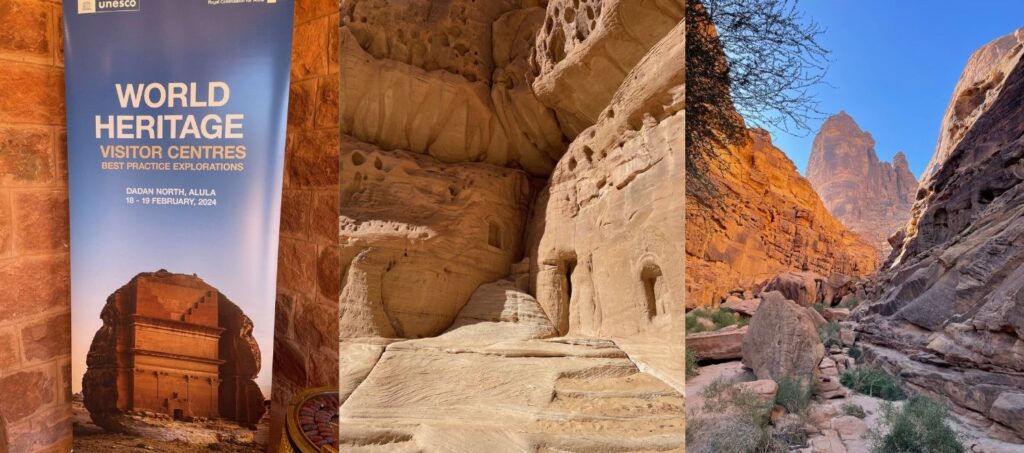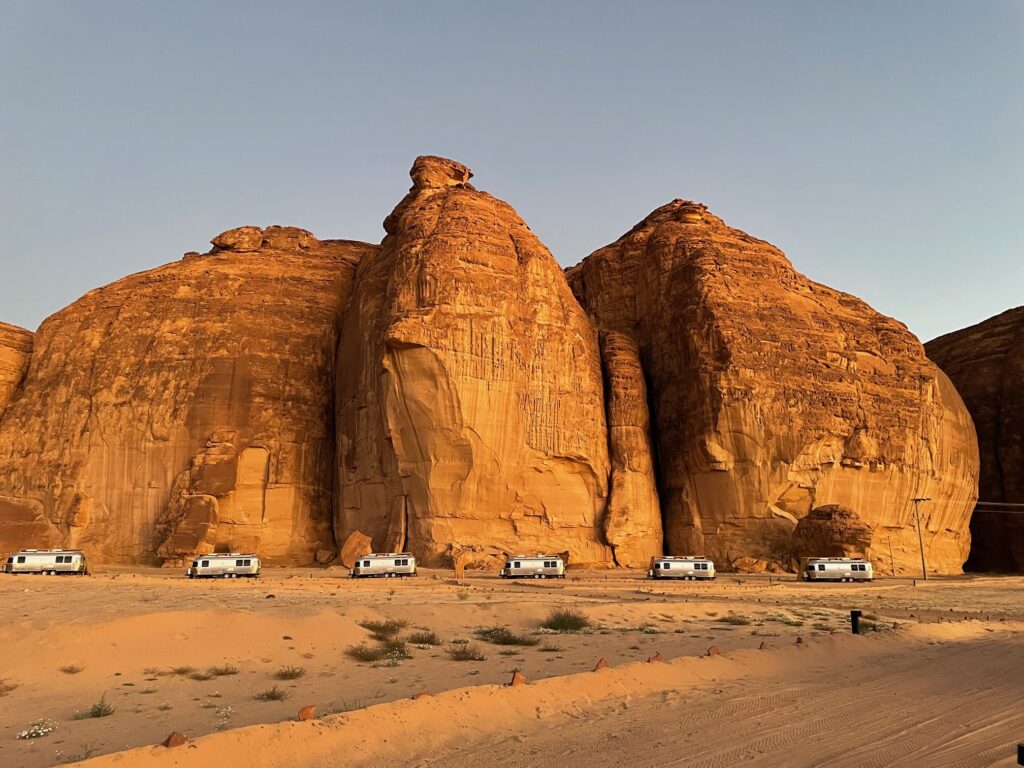UNESCO’s World Heritage Visitor Centre Best Practice Explorations
March 18, 2024
World Heritage UK Vice-Chair Tony Crouch recently took part in a UNESCO ‘Best Practice Workshop’ in Hegra, Saudi Arabia. His report is here, with all opinions expressed being those of the author.
Shifting Sands
Pre-2019, tourism visas to the Kingdom of Saudi Arabia (KSA) were non-existent. Inbound tourism was neither facilitated or required, and the few foreigners who found their way to the un-marked heritage sites were largely a spattering of overseas workers. In the following years however, this situation has shifted dramatically with World Heritage professionals at the very heart of this change.
Global dependency upon oil is falling and the 2030 Saudi Vision recognises the need for economic diversification. International tourism is identified as one replacement income source but growing a visitor market from scratch and opening up a deeply religious and previously insular society is a significant challenge. This is heritage-based regeneration on a national scale.
Very little in KSA seems to be done in half measures, but a staged approach based around the UNESCO World Heritage Sites is underway. The 7 sites in KSA (6 cultural, 1 natural) are accompanied by a burgeoning, tentative list. High spending cultural tourists, initially in modest numbers, will pave the way for potentially bigger volumes to follow. It will involve changing attitudes in society, but this is a young country with 70% of the population under 30 years old, so the time for change is surely now.
I recently contributed to the first of what is likely to be a series of workshops convened by UNESCO (at the request of KSA), intended to provide heritage advice, support and guidance. On this occasion we were at the World Heritage Site of Hegra, deep in the desert of the AlUla region, some 370 miles north of Jeddah in the west of KSA. This site contains 111 impressive rock tombs plus water wells carved from sandstone outcrops. The Nabatean people responsible for creating these tombs were a fiercely independent and culturally advanced Arab people, first recognised around the 4th century BC. They controlled the overland incense trade routes crossing the Arabian desert and travelers were taxed for safe passage and water. The Romans annexed the region in 106 AD. The considerable wealth accrued funded the creation of spectacular carved tombs both here and further North at Petra, in modern day Jordan. The site at Hegra currently receives around 66k annual tourists, two-thirds coming from KSA and 16% from Europe. By 2035 it is planned to increase overall numbers to 1.1m and widespread promotion is already underway with, for example, an exhibition at the Forbidden Palace in Beijing.

As with most archaeological sites, interpretation is vital, and a new regional visitor centre is proposed. This was the focus of the workshop, sharing recent experience from Bath (and the wider UK) alongside colleagues from Venice, the Palace of Versailles, the Alhambra, Robben Island (South Africa), Mogao Caves (China), the US National Parks Authority and a US based site capacity expert. The ‘home team’ from the Royal Commission for AlUla were very impressive, including much young talent drawn from the UK, some even balancing young families at home with regular commutes to KSA. The two-day workshop was excellent and is something we would have found hugely beneficial during the planning stages for the Bath World Heritage Centre.
My overall impression was that KSA are getting the basics very right. One highly successful feature is the ‘Rawis’, or storytellers, drawn from the local community. These young guides have been highly trained including with overseas placements and are the welcoming face of the sites providing key interpretation. They provide a perfect blend of what can be taught (facts, figures etc.) with what is intuitive. Our guide for example embellished his explanations with stories from his own family, plus he instinctively dropped to his haunches to create sand drawings. First rate tours guides are nothing new (we have the excellent Mayors Guides in Bath), but here the guides were highly impressive and have recreated a respected modern profession of storytelling. 96% of the Rawis are university educated and almost all are local. 61% of the wider AlUla team are women. Some of what KSA is staging can be labelled ‘immediate impact’ (formula 1 races, boxing bouts, golf, global football stars etc.), but this heritage training has real legacy value. These trained guides will provide a pool of talent for future museum professionals, and in a decade we may well see top heritage talent being exported instead of imported.
This is a fascinating journey to watch unfold. Whilst promising heritage building blocks are in place, success for KSA will ultimately depend upon wider infrastructure improvements. The region is hard to reach and AlUla airport will struggle to cope with the tourist volumes. Hotel beds are also in short supply, and despite creative work arounds (we stayed in a complex of ‘Airstream’ caravans), prices are high. Cultural perceptions (and misconceptions) about KSA held by westerners still need to be addressed, summer temperatures are blistering and you can’t get a chilled glass of wine (!).

I am not sure how usual it is for UNESCO to participate in specific programmes such as this, but in my opinion they are right to be in there. It is in the wider interest to get this right. Heritage being appreciated, valued and put to work in this way is contagious and commendable. Supporting a move away from oil also validates efforts being made worldwide. International tourism thrives on peace and political stability, which is something desperately needed in the middle east. For all these reasons, I wish our heritage colleagues in KSA every success and am glad that UK World Heritage experience is being of assistance.
Royal Commission for AlUla: https://www.rcu.gov.sa/en/
Visit Saudi: https://www.visitsaudi.com/en?gad_source=1&gclid=EAIaIQobChMI6O6blbT9hAMVK41QBh16pwatEAAYASAAEgJcHvD_BwE&gclsrc=aw.ds